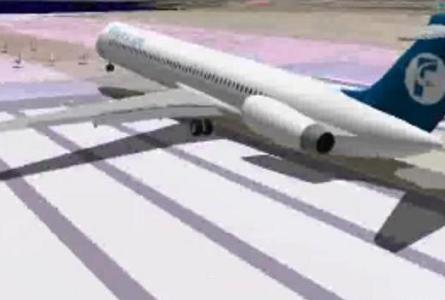Swedish investigators believe a Boeing MD-83 crew felt commercial pressure to depart Are-Ostersund Airport while above maximum weight limits, causing the jet to collide with airfield lighting as it climbed away.
The heavily-laden MD-83, with 169 passengers and six crew, was being operated by Austrian charter specialist MAP - on behalf of Turkish carrier Atlasjet - on a service to Antalya two years ago.
While the rotation was initiated at 151kt the nose-gear did not rise until the jet had reached 163kt, after a 47sec ground run and just 250m from the end of the runway. Its main wheels lifted with only 30m remaining, and the aircraft hit three sets of low-mounted approach lights - the furthest sited 87m beyond the runway.
The investigators calculated the MD-83's maximum permissible weight, for the conditions, to be 67.9t. But the figure on the load documentation showed a weight of 70.1t, itself an underestimate because 29 items of baggage in the forward hold had been omitted from the load sheet.
SHK says it seems "unlikely" that the experienced first officer would have overlooked the weight difference.
The pilots selected runway 30 because it generally allowed for higher-weight departures. But while this runway choice exposed the jet to a tailwind, the crew did not include crucial weather data in the take-off calculation.
SHK has been unable to explain the apparent blunder, but states: "It is difficult to imagine that both pilots would have been unaware of all the factors omitted in order to get on the right side of the performance limitations."
 |
|---|
Animation and image © SHK |
Lack of cockpit-voice recorder information "prevented a full picture of events" and the investigators "cannot state with certainty" the reasons behind the decisions made on the flight-deck. But SHK believes the pilots would have considered the economic consequences of offloading passengers, or having to make an intermediate refuelling stop.
It highlights "shortcomings in handling the balance between flight safety and production" during the event, and adds: "The reason this incident did not develop into a serious aviation accident can largely be attributed to fortunate circumstances."
MAP could not immediately comment on the investigation's conclusions.
Simulations performed by the investigators indicated a "substantial risk" that the aircraft would have been unable to stop on the runway if it had attempted to abort at the V1 decision speed. SHK adds that a survey of passengers on the flight indicates that the aircraft's true weight could have been 71.1t.
Source: Flight International



















